
- Citroën C-Zero

- IONIQ Electric
- New Kona Electric
- TUCSON 1.6 T-GDi HEV

- Mercedes-Benz C 350 e
- Mercedes-Benz S-500 Plug-In Hybrid

- OPEL Ampera

- Tesla Model S
- Tesla Model X

- Volkswagen e-Crafter
- Volkswagen e-up!
- Volkswagen e-Golf
- Volkswagen Passat GTE
- Volkswagen Golf GTE
Toyota Aqua - igazi világújdonság a hibrid kisautó bipoláris nikkel-hidrogén akkumulátora
Az öntöltő hibrid hajtásra tervezett városi modell valamivel nagyobb a vele szoros műszaki rokonságban álló Toyota Yaris-nál, különösen izgalmassá azonban nem nagyobb helykínálata, hanem világelső hipermodern bipoláris akkumulátora teszi.
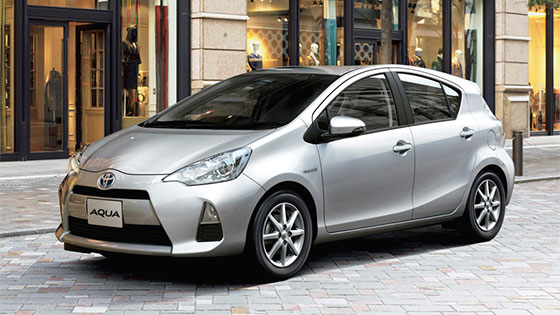
Toyota Aqua
Az autó elődmodelljét már bemutatták 2011-ben, az ötajtós Toyota Aqua a kategóriateremtő Prius kultuszát próbálta exportálni a B-szegmensbe, Észak-Amerikába egyenesen Prius C, azaz Prius Compact néven. A világ számos nagy piacán forgalmazott modell akkora volt, mint a Yaris, hibrid hajtáslánca megegyezett a vele egyidőben debütáló Yaris Hybrid-ével, formavilága pedig leginkább egy nyújtott Toyota Aygo-t idézett. Ennyi egyezés mellett nem csoda, hogy Európában nem értékesítették a modellt, Japánban azonban rendkívül népszerűnek bizonyult, három éven át vezette az újautó-eladások rangsorát. Érdekesség, hogy tíz éven át forgalmazták a modellt: ez rendkívül hosszú idő egy átlagos kisautó esetében, ám az Aqua-t eleve úgy harangozták be, hogy megérkezett "a következő évtized kisautója" és hazai piacán be is váltotta a hozzá fűzött reményeket.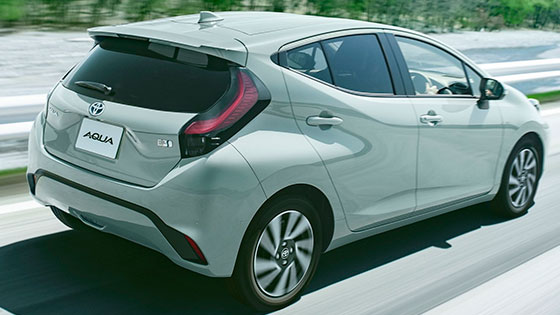
Toyota Aqua
A most bemutatott, második generációs Aqua esetében a Toyota ugyanezt a szlogent használja, ám ezúttal verhetetlen adut tart a kezében : a világ legfejlettebb, új generációs akkumulátor-technológiáját.A hagyományos nikkel-hidrogén akkumulátorok esetében az elektrolitban úszó anód és a katód között egy elválasztó, szigetelő réteg húzódik. Ezt a csomagot két oldalról egy-egy áramgyűjtő réteg fogja közre, az akkumulátorcellában ezt a többrétegű szendvics-szerkezetet helyezik el.
A világújdonságban, a bipoláris nikkel hidrogén akkumulátorban ezzel szemben az áramgyűjtő egyben az akkumulátorcella falaként is szolgál. A köztes réteg kiiktatása mintegy 40 százalékkal csökkenti az akkumulátor méretét, így helyigényét is, a technológiának azonban nem ez az egyetlen előnye: a rendszeren nagyobb áramerősség folyhat át, ezért a teljesítménye nagyságrendileg másfélszer akkora, mint egy azonos számú cellából álló, hagyományos nikkel-hidrogén akkumulátoré. Ez a két technológiai előny együttesen azt jelenti, hogy a bipoláris akkumulátor azonos méretben kétszer akkora teljesítményre képes, mint egy előző generációs egység.
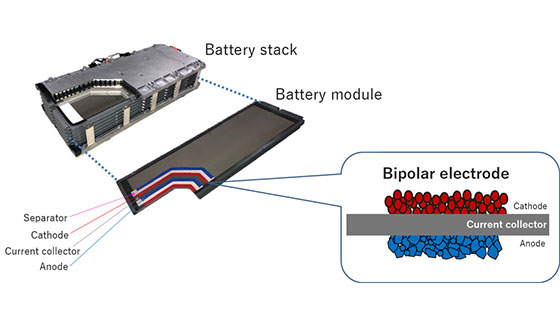
Toyota Aqua
A felhasználó szempontjából ez egyrészt dinamikusabb gyorsítóképességet és jobb gázreakciót, másrészt azonos akkumulátor-térfogatra vetítve nagyobb kapacitást, ezáltal hosszabb tisztán elektromos hatótávolságot jelent. Egy öntöltő hibrid Toyota már a jelenleg alkalmazott akkumulátor-technológiával is képes városban az üzemidő körülbelül 70 százalékában kizárólag villanymotorja segítségével haladni, az Aqua esetében pedig még kedvezőbb lesz ez az arány és ezzel párhuzamosan még tovább csökken a jármű üzemanyag-fogyasztása és károsanyag-kibocsátása.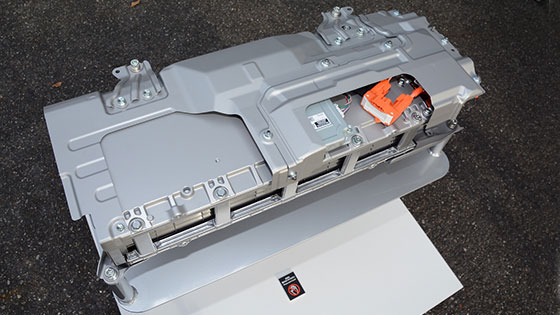
Toyota Aqua
A technológiát a világon elsőként alkalmazó, második generációs Toyota Aqua mintegy 20 százalékkal takarékosabb elődjénél, a globális WLTC norma szerint mért, vegyes üzemű átlagfogyasztása mindössze 2,8 liter/100 km! A bipoláris nikkel-hidrogén akkumulátor nagyobb teljesítménye egyéb előnyökkel is jár. Az Aqua alapfelszerelésként kínálja a 100 V-os fedélzeti váltóáramú csatlakozót, amelyről gyorsan tölthetők a mobiltelefonok, vagy működtethetők elektronikus készülékek.Áramszünet esetén az autó vészhelyzeti áramfejlesztő üzemmódba kapcsolható és ilyenkor akár 1500 W összteljesítményű háztartási berendezések, pl. vízforralók, hajszárítók vagy szerszámok üzemeltetésére is alkalmas.
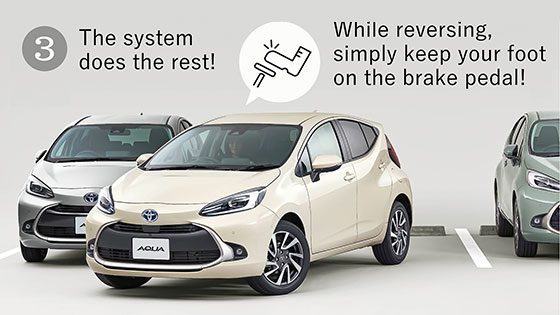
Toyota Aqua
Az Aqua az első olyan Toyota, amely alkalmas az egypedálos (Comfort Pedal) vezetésre: a regeneratív fékrendszer Power+ üzemmódban olyan erőteljes, az előző generációs rendszernél akár kétszer intenzívebb lassításra képes, ami a hétköznapi forgalmi helyzetek túlnyomó részében szükségtelenné teszi a fékpedál használatát. Ráadásul az Aqua elektromos összkerékhajtással is rendelhető: az E-Four rendszerben az első kerekeket hajtó öntöltő hibrid hajtáslánc kiegészül egy további villanymotorral, amely közvetlenül a hátsó kerekeket hajtja meg.Szintén az új generációs Aqua az első olyan városi Toyota modell, amely megkapta a fejlett Teammate parkolórobotot és parkolástámogató fékrendszert: az előbbi funkció képes teljesen önállóan bemanőverezni a járművet a kiszemelt parkolóhelyre, míg az autonóm fékrendszer a jármű 360 fokos környezetében, azaz nem csak elöl és hátul, de oldalt is észleli az akadályokat, és megakadályozza az ütközést.
Az európai vásárlók az ugyanerre az architektúrára épülő új generációs Toyota Yaris következő modellfrissítésekor számíthatnak rá, hogy a balkormányos modellben is megjelenik a Toyota előremutató, világelső akkumulátor-technológiája és annak járulékos előnyei.
News Release Models Toyota Aqua
Toyota to Launch All-New Aqua
The all-new Aqua is a hybrid electric-only compact car redesigned to realize Toyota's mission to "introduce sustainable vehicles practically," and to contribute to carbon neutrality.
- Since its launch, approximately 1.87 million Aqua units have been sold worldwide,
accounting for reductions in CO2 emissions of approximately 12.4 million tons
- The all-new Aqua is approximately 20% more fuel efficient than the previous
generation; it combines outstanding fuel efficiency of 35.8 km/L with the comfortable, high-quality ride of an electrified vehicle
- The latest generation inherits the Aqua DNA of a compact, convenient body size, and a class-beating, high-quality interior and exterior design.
Aiming to achieve carbon neutrality, Toyota has been making ever-better cars based on the concept of "introducing sustainable vehicles practically to the market".
As part of this process, the first-generation Aqua came to life at the Iwate Plant of Toyota Motor East Japan, Inc. (then, Kanto Auto Works, Ltd.) in 2011, the year of the Great East Japan Earthquake. With a desire to greatly increase hybrid-vehicle familiarity, as well as in pursuit of "creating a compact car for the next 10 years", the Aqua combined the superb practicality of a compact car with the outstanding fuel efficiency and quietness of a hybrid electric-only model at an affordable price. Since its launch, more than 1.87 million units of the Aqua have been cherished by their owners, contributing to an overall reduction in CO2 of approximately 12.4 million tons.
The all-new Aqua inherits and refines the roles undertaken by its predecessor, and, in pursuit of once again "creating a compact car for the next 10 years", in addition to a suite of features designed to enable customers to drive their vehicles every day with joy, safety, peace of mind, and comfort, it also realizes superior environmental performance. In addition to excellent environmental performance such as in the form of low fuel consumption at 35.8 kilometers per liter, it achieves high-quality driving performance by way of comfortable acceleration. Also, as can be expected, the Aqua comes with a full range of carefully considered equipment, including as standard on all grades a 100-volt (alternating current)/1,500-watt accessory power outlet and an emergency power supply mode that allows electricity to be drawn from the vehicle for external use during blackouts.
Toyota espouses the concept of a "home planet" and believes it has a duty to bequeath this beautiful Earth to future generations. Going forward, the company will continue to engage in making ever-better cars to contribute to the realization of carbon neutrality and the production of happiness for all through automobiles.
1. Combining the comfortable, refined ride and outstanding environmental performance of an electrified vehicle
(1) Innovative battery technologies
The all-new Aqua is the world's first vehicle to use a high-output bipolar nickel-hydrogen battery as an electric drive battery. Compared to the nickel-hydrogen battery equipped to the previous-generation Aqua, the new battery realizes approximately twice the output; it also delivers improved accelerator responsiveness, and enables smooth, linear acceleration from low speeds. In addition, the speed range at which the all-new Aqua can operate on electrical power alone has been expanded, allowing the vehicle to run on electricity alone, without engaging the engine, in a wide variety of urban scenarios.
For further information regarding the bipolar nickel-hydrogen battery, please see the section at the end of this release.
(2) A new driving experience unique to a hybrid electric vehicle (HEV)
The all-new Aqua is the first Toyota model to feature the Comfort Pedal. By selecting the Power+ Mode, drivers only have to relax pressure on the accelerator pedal to generate regenerative braking force, and smoothly slow the vehicle. The Comfort Pedal reduces driver burden by lessening the frequency with which accelerator and brake pedals have to be pressed, and also results in responsive feedback. The latest generation is also the first Aqua to adopt E-Four, which provides drivers with greater peace of mind when driving on snow-covered roads.
Thanks to a highly efficient 1.5-liter Dynamic Force Engine and an optimized HEV system, the all-new Aqua not only achieves compact class-leading fuel economy of 35.8 km/L, but combines this with the comfortable driving characteristics of an HEV.
2. Cutting-edge safety and security functions
(1) The latest active safety package
The Aqua is a model intended for frequent use in its owners' everyday lives, and Toyota believes it ought to be equipped with an abundance of safety and security functions. The allnew Aqua is equipped as standard with the latest edition of Toyota Safety Sense, which is replete with cutting-edge active safety functions: its pre-collision safety functions feature an expanded scope of operation, now covering accidents that occur when turning left or right at intersections; Full Speed Range Radar Cruise Control makes car outings more comfortable; Lane Tracing Assist (LTA) provides steering support to keep the vehicle centered in its lane; and Plus Support controls sudden acceleration due to misapplication of the accelerator pedal.
For the first time in a Toyota compact car, the all-new Aqua is equipped with Toyota Teammate Advanced Park and Parking Support Brake. Toyota Teammate Advanced Park provides support for all parking operations, including steering wheel, brake, accelerator, and gear shifting operations; in addition to detecting stationary objects in front of and behind the vehicle, the latest version of Parking Support Brake is capable of detecting stationary objects on either side, and provides alerts and brake control to help avoid collisions. In this way, the all-new Aqua delivers driver support in a wide range of scenarios, including when driving and parking.
(2) All grades are equipped with power supply functions, for use in times of disaster and other emergencies
An accessory power outlet (AC100 V / 1,500 W) and an emergency power supply mode are equipped to all grades as standard. During blackouts and other times of emergency, parking the vehicle and placing it in Emergency Power Supply Mode enables the Aqua to be used to power electrical appliances such as electric kettles and hair dryers. When driving normally, the vehicle can be used to power appliances via its accessory power outlet, and also to charge smartphones and other electrical devices via its in-cabin USB terminals.
3. A refined body structure and an advanced design
(1) The convenience of a compact car and the refined ride of a high-rigidity body
By using the TNGA (GA-B) platform in the same compact body as before, the all-new Aqua realizes a high-rigidity body, exceptional quietness, and a stable ride. While retaining the same, compact body size ideally suited to Japanese road conditions, the Aqua's wheelbase has been extended by 50 mm; this provides both greater space particularly for passengers seated in the rear seats, and expands the luggage space, resulting in greater convenience.
(2) An elegant, simple, and class-beating design based on the principle of Harmo-tech (Advanced yet familiar technologies that stimulate the intellect and the senses)
A relaxed, unified cabin silhouette is coupled with rear fenders that extend out to the sides, creating a smart, emotional, and dynamic exterior that befits the Aqua. The vehicle is available in a total of nine, high-quality colors; this includes the newly developed Clear Beige, which delivers a simple, clear impression well-matched to the Aqua's smart form.
In the interior, various functions have been placed together to create a simple, clean, and elegant-looking space. Its cabin features soft, synthetic leather-bound ornaments and armrests, and convenient and comfortable synthetic leather power seats, which exceed all expectations; cabin storage has also been cleverly designed with convenience in mind―a tissue box can be stored in the front passenger seat upper box, while a center console sliding tray enables charging cables to be cleanly stowed away. The all-new Aqua also becomes the first Toyota compact car to feature a large, 10.5-inch audio display, delivering outstanding operability and visibility.
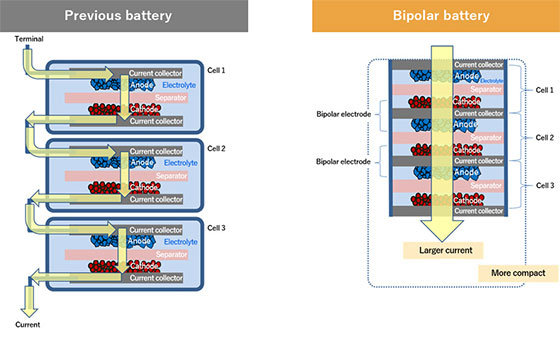
Bipolar battery
About bipolar nickel-hydrogen batteriesToyota believes that eco-friendly vehicles benefit society only when they come into
widespread use and contribute to reductions in CO2; for this reason, based on the idea of "introducing sustainable vehicles practically," it is developing a full line-up of electrified vehicles - comprising HEVs, PHEVs, BEVs, and FCEVs - and is accelerating efforts to offer its customers a wide range of choices.
Since the launch of the first-generation Prius, Toyota has accumulated expertise both in the technological development and the quality management of batteries and hybrid systems; Toyota Industries Corporation, meanwhile, has developed proficiency in analysis technologies for the development and performance assessment of materials, through many years of developing batteries for electrified forklift trucks.
By combining their respective fields of knowledge, the two companies have worked to
develop batteries so that they can bring electrified vehicles to the market and establish them as soon as possible. Their efforts have led to the development of bipolar nickel-hydrogen batteries which, compared to previous generations of batteries, are both more compact and capable of generating higher outputs.
The main characteristics of bipolar nickel-hydrogen batteries are outlined below.
In bipolar nickel-hydrogen batteries, a cathode is applied to one side of the current collector, and an anode to the other; several of these structures, which are known as "bipolar electrodes," are stacked together to form a battery.
Compared to non-bipolar nickel-hydrogen batteries, bipolar versions consist of fewer current collectors and other parts, enabling them to be made more compact. It is possible to stack a larger number of cells in bipolar nickel-hydrogen batteries than in non-bipolar nickelhydrogen batteries of the same size.
In addition, since bipolar batteries have a greater active surface area and a simpler
construction, there is lower resistance within the battery itself. This enables the flow of larger currents, leading to increased output. To take an example, the bipolar nickel-hydrogen battery equipped to the all-new Aqua has an output approximately two times higher* than the non-bipolar nickel-hydrogen battery equipped to the previous-generation Aqua.
*Compared to the previous-generation nickel-hydrogen battery, the all-new bipolar nickelhydrogen battery delivers 1.5-times greater output per cell, and packs 1.4-times more cells in the same-sized space; together, this leads to a total output increase of approximately twofold.
The all-new Aqua takes advantage of the increased output of its bipolar nickel-hydrogen battery to deliver improved accelerator responsiveness, and realize smooth, powerful acceleration from low speeds. In addition, the speed range at which the all-new Aqua can operate on battery power alone has been expanded, allowing the vehicle to run on electricity alone, without engaging the engine, in a wide variety of urban scenarios.
#Toyota #Aqua #Yaris #Prius #Hybrid #Aygo #Teammate #HEV #bipolar #TNGA






























 /zoldhajtas.hu
/zoldhajtas.hu /villany_autok
/villany_autok  /4x4onlineH
/4x4onlineH

